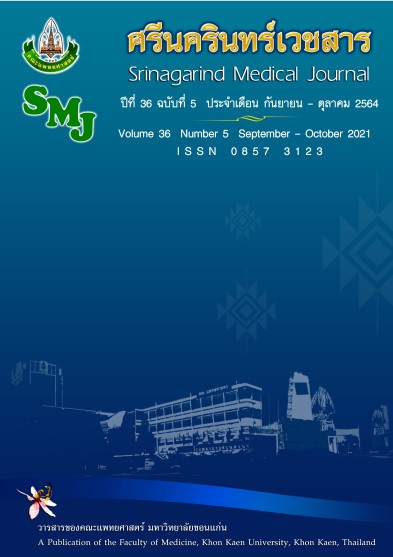การวัดมุมของปากมดลูกกับตัวมดลูกด้วยการตรวจอัลตราซาวน์ทางช่องคลอด ในช่วงไตรมาสที่ 2 ของการตั้งครรภ์เพื่อประเมินความเสี่ยงในการคลอดก่อนกำหนดในสตรีตั้งครรภ์เดี่ยว
Abstract
Ultrasound Uterine Cervical Angle Screening At Second Trimester to Predict Spontaneous Preterm Birth in Singleton Pregnancy
Sukanya Chaiyarach, Kiattisak Kongwattanakul, Ratana Komwilaisak
Department of Obstetrics and Gynecology, Faculty of Medicine, Khon Kaen University.
Received: 14 June 2021 / Edit: 9 July 2021 / Accepted: 6 August 2021
Corresponding author: Sukanya Chaiyarach, Department of Obstetrics and Gynecology, Faculty of Medicine, Khon Kaen University. E-mail: sukancha@kku.ac.th
หลักการและวัตถุประสงค์: กลไกพื้นฐานของการคลอดก่อนกำหนดมีหลายอย่าง การเปลี่ยนแปลงของปากมดลูกเป็นหนึ่งในกลไกที่สำคัญของการคลอดก่อนกำหนด สามารถอธิบายจากโครงสร้างของปากมดลูกทั้งความยาวของปากมดลูก (cervical lenght: CL) และมุมของปากมดลูกกับตัวมดลูก (uterine cervical angle: UCA) ในปี ค.ศ. 2016 และ 2018 มีรายงานการศึกษาพบมุมของปากมดลูกกับตัวมดลูก สัมพันธ์กับอายุครรภ์ที่คลอด สามารถนำมาใช้ทำนายการคลอดก่อนกำหนดได้ แต่อย่างไรก็ตามการศึกษามีเฉพาะแถบอเมริกาและยุโรป ซึ่งความเสี่ยงของการคลอดก่อนกำหนดจะแตกต่างกันในแต่ละเชื้อชาติ การศึกษานี้มีวัตถุประสงค์หลักเพื่อศึกษา
วิธีการศึกษา: การศึกษาแบบตัดขวางในสตรีตั้งครรภ์เดี่ยวอายุ 18 ปีขึ้นไปที่มาฝากครรภ์ และได้รับการตรวจอัลตราซาวด์ที่แผนกผู้ป่วยนอกโรงพยาบาลศรีนครินทร์
ผลการศึกษา: ค่าเฉลี่ยอายุครรภ์ (Mean±SD), CL, UCA และค่าเฉลี่ยอายุครรภ์เมื่อคลอด อยู่ที่ 20.20±1.30 สัปดาห์ 3.74±0.67 ซม., 93.93±18.75 องศา และ 38.37±1.84 สัปดาห์ตามลำดับ ความสัมพันธ์ของ UCA กับการคลอดก่อนกำหนดพบว่า UCA ที่น้อยกว่า 97 องศา เสี่ยงต่อคลอดก่อนกำหนดมากขึ้น โดยมีความไว ร้อยละ 57.9 ความจำเพาะ ร้อยละ 54.9 การพยากรณ์ผลบวกร้อยละ 14.7 และค่าพยากรณ์ผลลบร้อยละ 90.7
สรุป: UCA ที่มีค่าน้อยกว่า 97 องศา เสี่ยงต่อคลอดก่อนกำหนดมากขึ้น โดยมีความไว ร้อยละ 57.9 ความจำเพาะ ร้อยละ 54.9 การพยากรณ์ผลบวกร้อยละ 14.7 และค่าพยากรณ์ผลลบร้อยละ 90.7
คำสำคัญ: มุมมดลูกผ่านช่องคลอด; ทำนายการคลอดก่อนกำหนด; ไตรมาสที่สอง
Background and Objective: The preterm delivery was dependents on various factors, includes with cervical changes. The study of 2016 and 2018 in Europe and Americas found the cervical length (CL), uterine cervical angle (UCA) and gestational age were predictive factors for preterm delivery. Risk for preterm delivery may varies for difference races. Primary objective was prediction of spontaneous preterm birth with UCA in Northeastern Thailand population.
Methods: A cross sectional study in single pregnancy, age > 18 years with ultrasonographic examination at antenatal care unit, Srinagarind Hospital.
Results: The mean of gestational age, CL, UCA and gestational age at delivery were 20.20±1.30 yr., 3.74±0.67 cm, 93.93±18.75 degree and 38.37±1.84 weeks, respectively. The preterm delivery was associated with UCA< 97 degree. Sensitivity, specificity, positive predictive value and negative predictive value were 57.9%, 54.9%, 14.7% and 90.7%, respectively.
Conclusion: The preterm delivery was associated with UCA<97 degree. Sensitivity, specificity, positive predictive value and negative predictive value were 57.9%, 54.9%, 14.7% and 90.7%, respectively.
Keywords: Transvaginal uterocervical angle; predict preterm birth; second trimester


